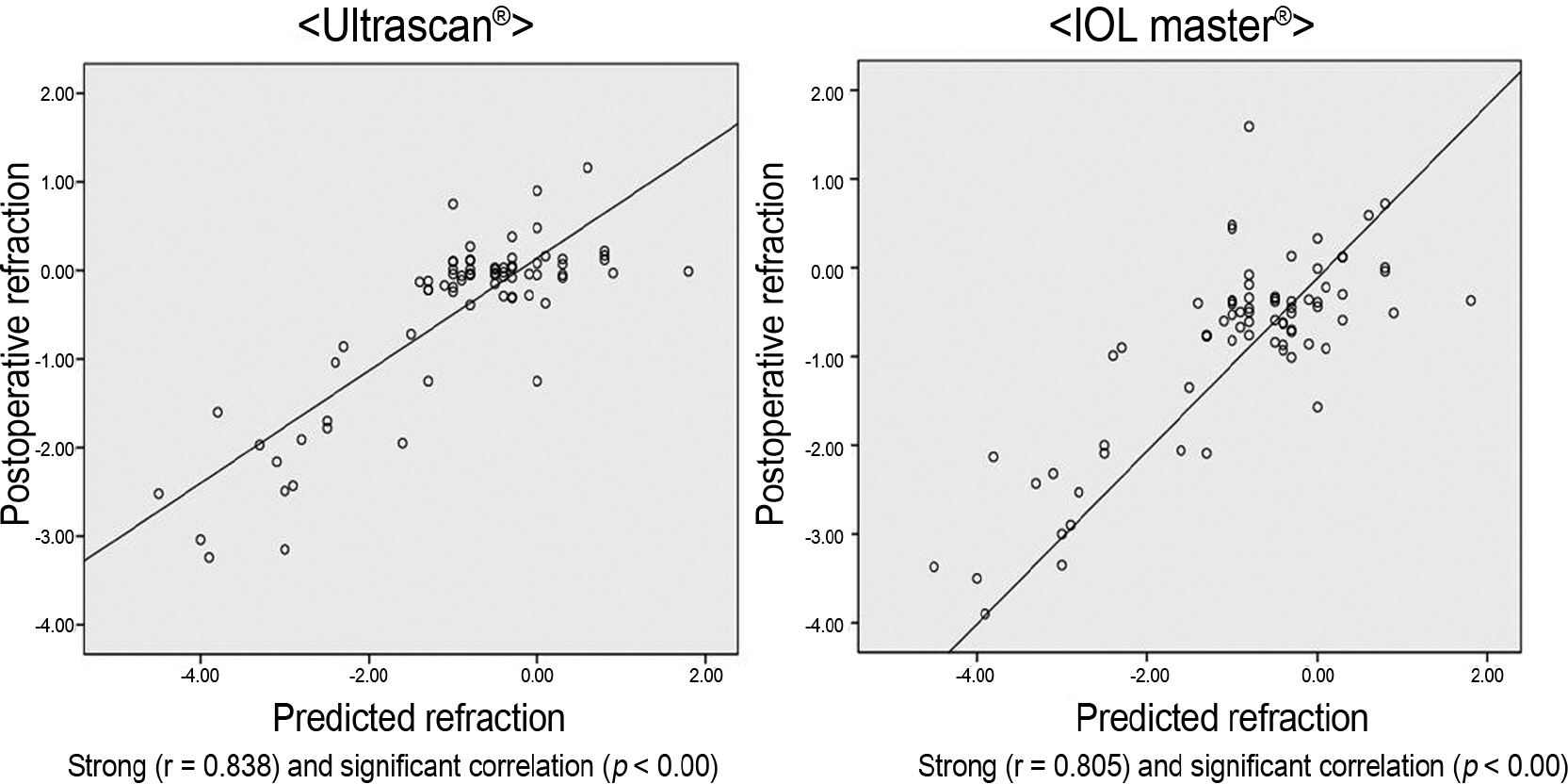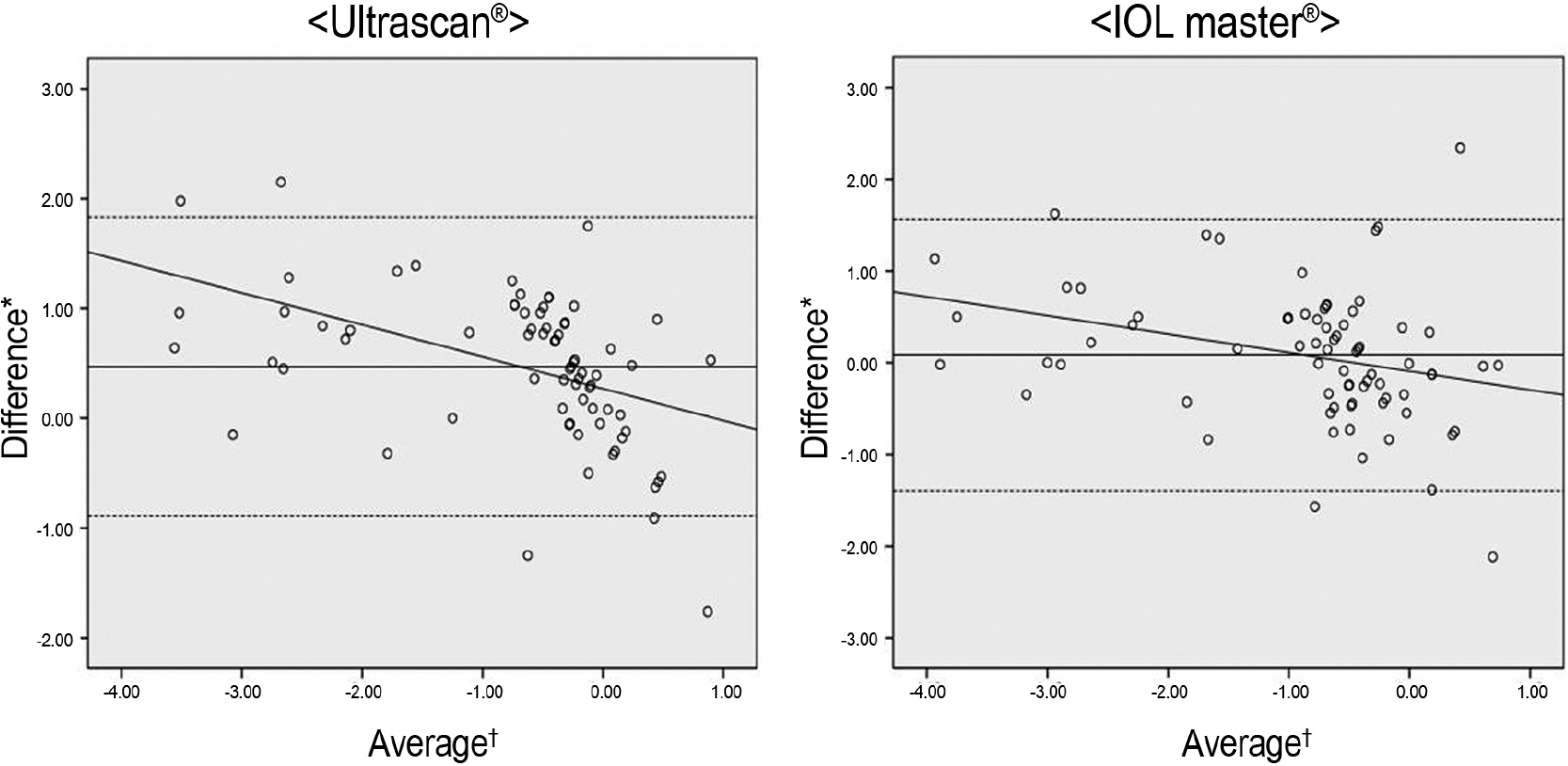J Korean Ophthalmol Soc.
2015 Jul;56(7):1059-1064. 10.3341/jkos.2015.56.7.1059.
Comparison of the Postoperative Refractive Errors Measured by Ultrasound and Partial Coherence Interferometers after Phacovitrectomy
- Affiliations
-
- 1Department of Ophthalmology, Yeungnam University College of Medicine, Daegu, Korea. changwh@ynu.ac.kr
- KMID: 2148806
- DOI: http://doi.org/10.3341/jkos.2015.56.7.1059
Abstract
- PURPOSE
To compare the accuracy of refractive outcome measured by Ultrascan(R) (Alcon, Fort Worth, TX, USA) and partial coherence interferometers after phacovitrectomy.
METHODS
We performed a retrospective study in 74 eyes of 74 patients who underwent phacovitrectomy. SRK-T formula was used to predict intraocular lens (IOL) power. The difference between the predicted and postoperative refractive outcomes for the 2 methodologies (Ultrascan(R) and IOL Master(R) [Zeiss, Carl Zeiss, Jena, Germany]) were compared. The predicted refractive outcome was defined as the estimated refractive error when the selected IOL was inserted.
RESULTS
The axial length measured using IOL Master(R) was statistically longer than when measured using Ultrascan(R) (23.85 +/- 0.15 mm, 23.56 +/- 0.15 mm, p < 0.001). Based on keratometry, statistically significant difference between the 2 groups was not observed. The postoperative refractive error was more accurate when using the IOL Master(R) than Ultrascan(R) (0.08 +/- 0.74, 0.47 +/- 0.69, p < 0.001). However, in cases of vitreous hemorrhage, the postoperative refractive error was 0.42 +/- 0.49 with the IOL Master(R) and 0.07 +/- 0.54 with the Ultrascan(R).
CONCLUSIONS
Generally, IOL Master(R) is a more accurate method for calculating the IOL power prior to phacovitrectomy. However, in cases of vitreous hemorrhage, Ultrascan(R) appears superior to IOL Master(R) when calculating the IOL power.
Keyword
MeSH Terms
Figure
Reference
-
References
1. Koenig SB, Han DP, Mieler WF, et al. Combined phacoemulsifica-tion and pars plana vitrectomy. Arch Opthalmol. 1990; 108:362–4.
Article2. Scharwey K, Pavlovic S, Jacobi KW. Combined clear corneal pha-coemulsification, vitreoretinal surgery, and intraocular lens implantation. J Cataract Refract Surg. 1999; 25:693–8.
Article3. Han NS, Lee SB, Kim YB, Jo YJ. Results of triple surgery: cataract extraction, intraocular lens implantation and vitrectomy for retinal detachment. J Korean Ophthalmol Soc. 2004; 45:2041–6.4. Giers U, Epple C. Comparison of A-scan device accuracy. J Cataract Refract Surg. 1990; 16:235–42.
Article5. Findle O, Drexler W, Menapace R, et al. Improved prediction of in-traocular lens power using partial coherence interferometry. J Cataract Refract Surg. 2001; 27:861–7.6. Tehrani M, Krummenauer F, Blom E, Dick HB. Evaluation of the practicality of optical biometry and applanation ultrasound in 253 eyes. J Cataract Refract Surg. 2003; 29:741–6.
Article7. Shioya M, Ogino N, Shinjo U. Change in postoperative refractive error when vitrectomy is added to intraocular lens implantation. J Cataract Refract Surg. 1997; 23:1217–20.
Article8. Kovács I, Ferencz M, Nemes J, et al. Intraocular lens power calcu-lation for combined cataract surgery, vitrectomy and peeling of epi-retinal membranes for macular edema. Acta Ophthalmol Scand. 2007; 85:88–91.9. Falkner-Radler CI, Benesch T, Binder S. Accuracy of preoperative biometry in vitrectomy combined with cataract surgery for patients with epiretinal membranes and macular holes: results of a pro-spective controlled clinical trial. J Cataract Refract Surg. 2008; 34:1754–60.10. Gu BY, Sagong M, Chang WH. Phacovitrectomy versus vi-trectomy only for primary rhegmatogenous retinal detachment repair. J Korean Ophthalmol Soc. 2011; 52:537–43.
Article11. Hurley C, Barry P. Combined endocapsular phacoemulsification, pars plana vitrectomy, and intraocular lens implantation. J Cataract Refract Surg. 1996; 22:462–6.
Article12. Androudi S, Ahmed M, Fiore T, et al. Combined pars plana vi-trectomy and phacoemulsification to restore visual acuity in pa-tients with chronic uveitis. J Cataract Refract Surg. 2005; 31:472–8.
Article13. Holladay JT, Prager TC, Ruiz RS, et al. Improving the predict-ability of intraocular lens power calculations. Arch Ophthalmol. 1986; 104:539–41.
Article14. Haigis W, Lege B, Miller N, Schneider B. Comparison of im-mersion ultrasound biometry and partial coherence interferometry for intraocular lens calculation according to Haigis. Graefes Arch Clin Exp Ophthalmol. 2000; 238:765–73.
Article15. Rajan MS, Keilhorn I, Bell JA. Partial coherence laser inter-ferometry vs conventional ultrasound biometry in intraocular lens power calculations, Eye (Lond). 2002; 16:552–6.16. Auffarth GU, Tetz MR, Biazid Y, Völcker HE. Measuring anterior chamber depth with Orbscan Topography system. J Cataract Refract Surg. 1997; 23:1351–5.17. Manvikar SR, Allen D, Steel DH. Optical biometry in combined phacovitrectomy. J Cataract Refract Surg. 2009; 35:64–9.
Article18. Kunavisarut P, Poopattanakul P, Intarated C, Pathanapitoon K. Accuracy and reliability of IOL master and A-scan immersion bio-metry in silicone oil-filled eyes. Eye (Lond). 2012; 26:1344–8.
Article19. Shin JA, Chung SK. Comparison of the refractive results measured by ultrasound and partial coherence interferometers. J Korean Ophthalmol Soc. 2013; 54:723–7.
Article20. Shin DH, Lim DH, You JY, et al. Formula comparison for intra-ocular lens power calculation using IOL master and ultrasound for the ZCB00 IOL. J Korean Ophthalmol Soc. 2014; 55:527–33.
Article
- Full Text Links
- Actions
-
Cited
- CITED
-
- Close
- Share
- Similar articles
-
- Comparison of Ocular Biometry Measured by Ultrasound and Two Kinds of Partial Coherence Interferometers
- Comparison of Ocular Biometry Measurements Using A-Scan Ultrasound and Two Types of Partial Coherence Interferometers
- Comparison of the Refractive Results Measured by Ultrasound and Partial Coherence Interferometers
- Accuracy of Intraocular Lens Power Estimation in Eyes Undergoing Phacovitrectomy for Proliferative Diabetic Retinopathy
- Postoperative Refractive Errors after Phacovitrectomy with Sulcus Fixation of an Intraocular Lens



